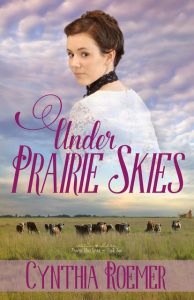Today I’m excited to host my friend, and fellow author, Cynthia Roemer, on Romancing History. You can learn more about Cynthia’s new release, Under Prairie Skies, below. Leave a comment below to be entered into a drawing for a FREE Kindle copy of Under Prairie Skies.
A Good Old-Fashioned Shivaree
I’m willing to bet not many of you have heard of a Shivaree. It’s an almost forgotten bit of wedding history. Nowadays, we celebrate marriages with banquets, toasts, honeymoons, and photo shoots. But there was a time, friends and neighbors gathered to give the happy couple a send-off they wouldn’t soon forget, one that included a surprise visit in the dead of night and lots of noise!
Shivarees were a rather raucous and fun-loving way of celebrating a newly married couple’s nuptials. It could take place days, weeks, or months following the actual wedding. The element of surprise was key.
Though more prevalent in the 1800’s, my parents told me stories of shivarees that took place in their growing up years extending into the mid-1900s. According to them, the Shivaree began with a late-night wake-up call of banging pans and noise-makers, include a serenade of songs such as Let Me Call You Sweetheart, and ended with the sharing of snacks and desserts, often provided by the newly married couple.
Shivarees of the nineteenth century were much bolder and at times down right ornery. I didn’t realize just how ornery until I did some research for a scene in my novel, Under Prairie Skies. Set in 1855, the scene has my main characters, Chad and Charlotte, and a host of others, traveling by the light of the moon to the unsuspecting couple’s home.
There, the bride and groom are awakened by rifle fire and banging pans. The barefoot groom is then blindfolded and spirited away in his nightshirt into the timber and left to fend for himself until daybreak. All the while, his poor, bewildered bride is wailing and calling his name. Not the best way to wish a new couple a joyous marriage! I won’t share any spoilers by telling how the scene evolves, but during it, Chad’s actions further endear him to Charlotte.
Though I’ve not participated in or even known anyone to be shivareed, my husband attended one for his cousin when he was a boy. So, when we married, my husband had me more than a little nervous we would end up with his extended family outside our bedroom window some dark night banging pans and serenading us.
My fears never came to fruition, but all that first summer, I did a lot of baking and learned to be a very light sleeper.
About the Book
~ Beyond shattered dreams lies a realm of possibilities ~
Illinois prairie ~1855
 Unsettled by the news that her estranged cousin and uncle are returning home after a year away, Charlotte Stanton goes to ready their cabin and finds a handsome stranger has taken up residence. Convinced he’s a squatter, she throws him off the property before learning his full identity. Little does she know, their paths were destined to cross again.
Unsettled by the news that her estranged cousin and uncle are returning home after a year away, Charlotte Stanton goes to ready their cabin and finds a handsome stranger has taken up residence. Convinced he’s a squatter, she throws him off the property before learning his full identity. Little does she know, their paths were destined to cross again.
Quiet and ruggedly handsome, Chad Avery’s uncanny ability to see through Charlotte’s feisty exterior and expose her inner weaknesses both infuriates and intrigues her. When a tragic accident incites her family to move east, Charlotte stays behind in hopes of becoming better acquainted with the elusive cattleman. Yet Chad’s unwillingness to divulge his hidden past, along with his vow not to love again, threatens to keep them apart forever.
Under Prairie Skies is available at Amazon Barnes & Noble and Book Bub
Meet the Author
 Cynthia Roemer is an award-winning inspirational author with a heart for scattering seeds of hope into the lives of readers. Raised in the cornfields of rural Illinois, Cynthia enjoys spinning tales set in the backdrop of the 1800s prairie. Her Prairie Sky Series consists of Amazon Best-Seller Under This Same Sky, Under Prairie Skies, and Under Moonlit Skies, due to release September 10, 2019. She is a member of American Christian Fiction Writers and writes from her family farm in central Illinois where she resides with her husband of twenty-five years and two college-aged sons.
Cynthia Roemer is an award-winning inspirational author with a heart for scattering seeds of hope into the lives of readers. Raised in the cornfields of rural Illinois, Cynthia enjoys spinning tales set in the backdrop of the 1800s prairie. Her Prairie Sky Series consists of Amazon Best-Seller Under This Same Sky, Under Prairie Skies, and Under Moonlit Skies, due to release September 10, 2019. She is a member of American Christian Fiction Writers and writes from her family farm in central Illinois where she resides with her husband of twenty-five years and two college-aged sons.
Visit Cynthia online on her website, or connect with her on Facebook, Twitter, Goodreads or sign up for her author newsletter.
Giveaway
THIS GIVEAWAY IS NOW CLOSED. Congratulations to Paual Shreckhise the winner of the Kindle copy of Under Prairie Skies! Thanks to all who entered our giveaway!
To be entered into a drawing for a FREE Kindle copy of Under Prairie Skies, comment below and let us know if you’ve ever heard of a shivaree or some other unusual custom to celebrate a wedding or betrothal.




